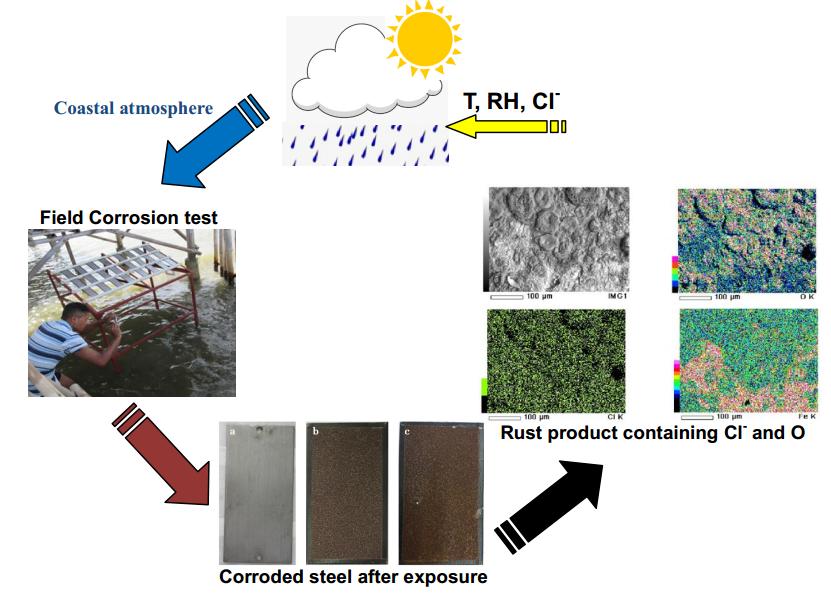A Field Study of Atmospheric Corrosion of Carbon Steel after Short Exposure in Pelabuhan Ratu, West Java Province, Indonesia
DOI:
https://doi.org/10.48048/wjst.2021.9667Keywords:
Carbon steel, Atmospheric corrosion, Coastal region, Relative humidity, Chloride depositionAbstract
The investigation of atmospheric corrosion of mild carbon steel as representative of offshore infrastructure has been carried out in the marine tropical of Pelabuhan Ratu, West Java, Indonesia. They are exposed up to 76 days of periods, and their corrosion rates are determined according to ASTM G1-03. The surface morphology, the elemental compositions and compounds were observed using a scanning electron microscope (SEM), energy dispersive spectroscopy (EDS) and X-ray diffraction (XRD), respectively. The environmental parameters of the test site are monitored during exposure, such as air temperature, relative humidity (RH), airborne salinity and dew temperature. Based on the results, the corrosion rates of steels were 2.79 and 2.8 mpy within the 27 and 76 days exposures, respectively. The presence of chloride deposition on the surface of steel can increase the severity of corrosion. Moreover, the detrimental effect of chloride was observed in rust product, which was covered by an oxygen element. The main phases of rust products present were magnetite (Fe3O4) and hematite (α-Fe2O3.H2O). Several cracks were observed in the rust layer, which tended to exfoliate and lose adherence and protectiveness from further corrosion attack.
HIGHLIGHTS
- The presence of chloride deposition on the surface of steel can increase the severity of corrosion.
- The severity of corrosion attack mainly depends on the exposure time and some climatic parameters, such as relative humidity (RH), air temperature and chloride airborne.
- The uniform distribution of the chloride tends to increase the production of ferrous chloride in high RH condition and the aqueous layer deposited on carbon steel.
- There are two phases on corroded carbon steel such as hematite (α-Fe2O3.H2O) and Magnetite (Fe3O4) after exposure
GRAPHICAL ABSTRACT
Downloads
Metrics
References
M Morcillo, J Alcántara, I Díaz, B Chico, J Simancas and DDL Fuente. Marine atmospheric corrosion of carbon steels. Rev. Metal. 2015; 51, e045.
GE Badea, P Cret, M Lolea and A Setel. Studies of carbon steel corrosion in atmospheric conditions. Acta Tech. Corviniensis Bull. Eng. 2011; 4, 25-8.
G Priyotomo, L Nuraini, S Prifiharni and Sundjono. Corrosion behavior of mild steel in seawater from Karangsong & Eretan of West Java Region, Indonesia. J. Kelautan Indonesian J. Mar. Sci. Tech. 2018; 11, 184-91.
S Sundjono, G Priyotomo, L Nuraini and S Prifiharni. Corrosion behavior of mild steel in seawater from Northern Coast of Java and Southern Coast of Bali, Indonesia. J. Eng. Tech. Sci. 2017; 49, 770-84.
M Morcillo, B Chico, J Alcantara, I Diaz, J Simancas and DDL Fuente. Atmospheric corrosion of mild steel in chloride-rich environments Questions to be answered. Mater. Corrosion 2015; 66, 882-92.
T Khaing, YYK Win and NM Kyaw. Study on rust characterization and prediction of atmospheric corrosion rates for structural steels in Yangon (Myanmar). In: Proceedings of the 3rd International Conference on Civil Engineering Research, Surabaya, Indonesia. 2017, p. 143-8.
P Castro-Borges and L Veleva. Time of wetness and HR-T complex as tools for corrosion risk evaluation in a concrete block exposed to a humid tropical environment. J. Construct. 2015; 14, 65-71.
L Nuraini, S Prifiharni, G Priyotomo, Sundjono, H Gunawan and I Purawiardi. Atmospheric corrosion performance of different steels in early exposure in the coastal area region West Java, Indonesia. AIP Conf. Proc. 2018; 1964, 020040.
S Feliu, M Morcillo and B Chico. Effect of distance from sea on atmospheric corrosion rate. Corrosion 1999; 55, 883-91.
PR Roberge. Hand Book of Corrosion Engineering. McGraw-Hill, New York, 2000.
P Castro-Borges and L Veleva. Time of wetness and HR-T complex as tools for corrosion risk evaluating in a concrete block exposed to a humid tropical environment. J. Construct. 2015; 14, 65-71.
ZW Li, NJ Marston and MS Jones. Update of New Zealand’s atmospheric corrosivity map. Branz, Judgeford, 2013.
RW Revie. Uhlig's Corrosion Handbook. John Wiley & Sons, Ontario, 2011.
R Vera and S Ossandón. On the prediction of atmospheric corrosion of metals and alloys in chile using artificial neural networks. Int. J. Electrochem. Sci. 2014; 9, 7131-51.
NG Smart, M Gamboa, JOM Bockris and J Aldeco. Corrosion mechanism of iron in concentrated acidic zinc chloride media. Corrosion Sci. 1993; 34, 759-77.
RA Antunes, I Costa and DLAD Faria. Characterization of corrosion products formed on steels in the first months of atmospheric exposure. Mater. Res. 2003; 6, 403-8.
JJS Rodrıguez, FJS Hernandez and JEG Gonzalez. XRD and SEM studies of the layer of corrosion products for carbon steel in various different environments in the province of Las Palmas (The Canary Islands, Spain). Corrosion Sci. 2002; 44, 2425-38.
A Raman, S Nasrazadani and L Sharma. Morphology of rust phases formed on weathering steels in various laboratory corrosion tests. Metallography 1989; 22, 79-96.
JA Jaen, J Iglesias and C Hernandez. Analysis of short-term steel corrosion products formed in tropical marine environments of Panama. Int. J. Corrosion 2012; 2012, 162729.
J Alcántara, B Chico, I Díaz, DDL Fuente and M Morcillo. Airborne chloride deposit and its effect on marine atmospheric corrosion of mild steel. Corrosion Sci. 2015; 97, 74-88.
BYR Surnam, CW Chui, H Xiao and H Liang. Investigating atmospheric corrosion behavior of carbon steel in coastal regions of Mauritius using Raman spectroscopy. Matéria (Rio J.). 2016; 21, 157-68.
MM Barneya, BP Embaid and A Nissan. Identifying phases in protective scale formed during high temperature corrosion. Corrosion Sci. 2017; 127, 21-6.
P Jin and S Nesic. Mechanism of magnetite formation in high temperature naphthenic acid corrosion by crude oil fractions. Corrosion Sci. 2017; 115, 93-105.
LTH Lien and HL Hong. Characteristics of corrosion product layer formed on weathering steel exposed to the tropical climate of Vietnam. Mater. Sci. Appl. 2013; 4, 6-16.
Downloads
Published
How to Cite
Issue
Section
License
Copyright (c) 2021 Walailak University

This work is licensed under a Creative Commons Attribution-NonCommercial-NoDerivatives 4.0 International License.













